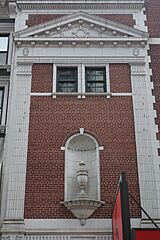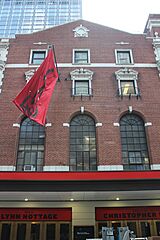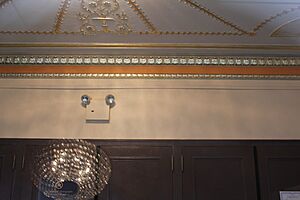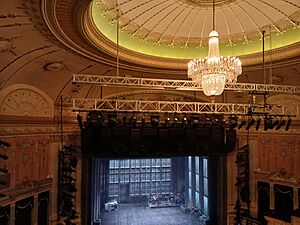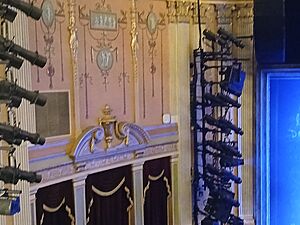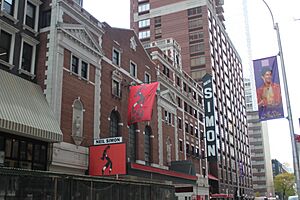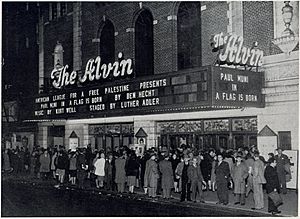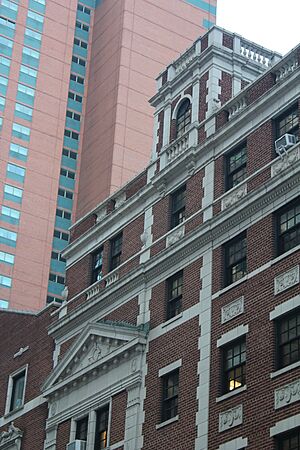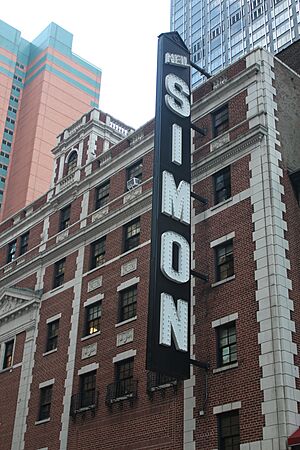Neil Simon Theatre facts for kids
|
Alvin Theatre (1927–1983)
|
|

Showing The Cher Show, 2019
|
|
| Address | 250 West 52nd Street Manhattan, New York United States |
|---|---|
| Coordinates | 40°45′47″N 73°59′04″W / 40.76306°N 73.98444°W |
| Owner | Nederlander Organization |
| Type | Broadway |
| Capacity | 1,467 |
| Production | MJ the Musical |
| Construction | |
| Opened | November 22, 1927 |
| Years active | 1927–present |
| Architect | Herbert J. Krapp |
| Designated | August 6, 1985 |
| Reference no. | 1305 |
| Designated entity | Facade |
| Designated | August 6, 1985 |
| Reference no. | 1306 |
| Designated entity | Auditorium interior |
The Neil Simon Theatre is a famous Broadway theater in New York City. It's located at 250 West 52nd Street in the busy Theater District of Midtown Manhattan. This theater first opened its doors in 1927. It was designed by a well-known architect named Herbert J. Krapp.
The theater was originally called the Alvin Theatre. This name was a mix of the first names of its original owners, Alex A. Aarons and Vinton Freedley. In 1983, the theater was renamed after the famous writer Neil Simon. The Neil Simon Theatre has 1,467 seats for audiences. It is managed by the Nederlander Organization. Both the outside of the building (the facade) and the inside of the main show area (the auditorium) are protected as important New York City landmarks.
The building has two main parts. The front part, where people enter, is five stories tall. The back part, which holds the stage, is six stories high. The bottom floor is decorated with special terracotta blocks. It has an entrance with a large sign called a marquee. The upper parts of the building are made of brick and terracotta. The front part has arched windows and special designs. The inside of the theater is designed in a classic style called Adam style. It has two lobbies and a lounge area. The main seating area has seats on the ground floor and one balcony above. The inside is decorated with fancy panels and plasterwork. The main seating area has a beautiful domed ceiling.
The Alvin Theatre officially opened on November 22, 1927. The very first show was a musical called Funny Face. In its early years, the theater hosted many popular musicals. These included Anything Goes, Lady in the Dark, and Something for the Boys. It also showed many plays. From 1946 to 1959, a company called CBS ran the theater. Then, it was sold to different owners. In 1975, the Nederlander Organization bought it. During the 1960s and 1970s, the Alvin Theatre had long runs of shows like A Funny Thing Happened on the Way to the Forum, High Spirits, and Annie. After it became the Neil Simon Theatre, it showed many of Neil Simon's plays. It also hosted the popular musical Hairspray for many years in the 2000s.
Contents
Where the Theater Is Located
The Neil Simon Theatre is at 250 West 52nd Street. It's on the south side of the street. This is between Eighth Avenue and Broadway. It's right in the middle of the Midtown Manhattan area of New York City. The theater building takes up a rectangular space. It is about 123.5 feet wide on 52nd Street. It is about 100 feet deep.
The Neil Simon Theatre shares its block with other famous places. These include the Mark Hellinger Theatre and Gallagher's Steakhouse. Other theaters nearby are the August Wilson Theatre and the Broadway Theatre.
How the Theater Was Designed
The Neil Simon Theatre was designed by Herbert J. Krapp. It was built in 1927. The outside of the building looks like the neo-Georgian style. The inside is designed in the Adam style. This style was common in many of Krapp's theater designs.
The Outside Look
The outside of the theater, called the facade, has two parts that are connected. The front part is five stories tall and wider. This is where the main entrance to the audience area is. The back part, which holds the stage, is six stories high. The upper parts of the building are made of red brick. They have terracotta decorations. The Neil Simon Theatre is one of only a few Broadway theaters with this neo-Georgian style. This style was meant to make people feel like they were "entering a producer's home."
The Bottom Part
The bottom part of both sections is made of special terracotta blocks. These blocks are designed to look like marble. On the front, there are two sets of metal and glass doors. A modern marquee (a large sign) hangs above these doors. There are also other doors for the stage area. A decorative band with panels runs above this bottom section.
The Upper Stories
Above the bottom part, vertical terracotta bands divide the front of the theater into three sections. The middle section has three rows of windows. Each row has a tall, arched window on the second story. These windows have terracotta decorations. On the fourth story, there are rectangular windows with terracotta frames. Above these are broken pediments with scrolls. The fifth-story windows also have rectangular frames. A triangular gable rises above these windows. It has a round window, called an oculus, in the center. This window is decorated with wreaths and flowers.
The outer sections of the front part are like small buildings. They have fluted terracotta pillars on the sides. Between these pillars are tall niches on the second story. These niches hold terracotta urns. Above each niche, the fourth story has two rectangular windows. The pillars support a decorative top part on the fifth floor. The left side has a low wall on top. The right side goes up another story, matching the height of the stage area.
The stage area is to the right of the main audience part. It is also divided into sections by terracotta bands. The windows here are rectangular. They have terracotta tops. The center sections of the stage area also have terracotta panels. There is a decorative top and paneling above the fifth floor. A low wall with a railing is above the sixth floor. The far left part of the stage area goes up to a seventh story. The far right part has a tall sign with the theater's name.
Inside the Theater
Lobbies and Lounge
When you enter, you first reach the ticket lobby. It has dark marble walls. On one side, there are ticket windows. On the other, there is a door to the inner lobby. The main entrance doors from the street are on one wall. Wooden doors to the main seating area are on another. The ceiling is decorated with plasterwork in the Adam style. It has crystal lamps.
The inner lobby is a rectangular room. You can enter it from the ticket lobby or directly from the street. It has wooden doors leading to the main seating area. A staircase on one side goes up to the mezzanine lounge. This lobby's ceiling also has Adam-style plasterwork and crystal chandeliers.
The mezzanine lounge was designed to look like an English lounge. Its walls have wood panels and lighting fixtures. It used to have a fireplace. Several "retiring rooms" were off this lounge, including smoking rooms. The lounge ceiling has an oval dome with plaster decorations and a central chandelier. Staircases from the lounge lead down to the inner lobby and the main seating area. These stairs were placed here so that people arriving late wouldn't disturb the show.
The Main Seating Area
The main seating area, called the auditorium, has seats on the ground level (orchestra) and one balcony. There are also special boxes on the sides. The stage is behind a large arch called the proscenium arch. The auditorium is decorated with plaster designs. It is almost square. The theater has about 1,467 seats. The original colors were ivory, blue, gray, and gold. Many of the original decorations are now covered with white paint.
Seating Sections
The orchestra level slopes down towards the stage. At the back of the orchestra, there is a walking area with a marble railing. Two columns, looking like marble pillars, separate this area from the seats. The side walls of the orchestra have metal doorways and wooden doors. The exit signs above the doors have decorations of lyres and griffins.
The balcony level is split into front and back sections by an aisle. This aisle has a metal railing. Exit doors on the side walls are also decorated with lyres and griffins. The rest of the balcony's side walls have pillars with decorations. These support a decorative band around the auditorium. Each side section has crystal and brass lights. The front railing of the balcony has decorative patterns. The underside of the balcony has Adam-style panels with crystal lights.
On each side of the stage, there are three boxes at the balcony level. These boxes step down towards the stage. The front box curves into the stage arch. The back box curves into the balcony. The undersides of the boxes have crystal lamps. The front railings of the boxes have decorative patterns. Pillars separate the boxes.
Other Design Details
Next to the boxes is the flat proscenium arch. It has fluted pillars on each side and a decorative top. Above the arch is a curved panel with a painting. This painting shows a peaceful scene with characters from myths. The stage behind the arch was very wide and deep. It had many dressing rooms for performers.
The ceiling has curved sections on the side walls. These are separated by decorated ribs. At the front of the auditorium, there is a round dome with a crystal chandelier. Behind the dome, the ceiling has panels with Adam-style plasterwork. Above the back balcony, there is a half-dome. Air conditioning vents are also in the ceiling.
History of the Theater
The Times Square area became the main place for big theater shows in the early 1900s. The Alvin Theatre was one of the last theaters built before the Great Depression. The theater's name came from its first operators, Alex A. Aarons and Vinton Freedley. Both men were from Philadelphia. Aarons produced musicals, and Freedley was a well-known producer. They worked together until 1933. Today, the theater is run by the Nederlander Organization. Since 1983, it has been named after Neil Simon, a very famous playwright.
How It Started and Early Years
In January 1927, Alexander Pincus and M. L. Goldstone bought the land for the theater. They planned to build a theater there. Pincus had built other theaters before. They planned to spend $1.4 million on the theater. Herbert J. Krapp was chosen as the architect. By October 1927, Aarons and Freedley had rented the theater. They planned to show the musical Funny Face, starring Fred and Adele Astaire. The Alvin Theatre opened on November 22, 1927, with Funny Face. That show ran for 250 performances.
The first few musicals at the Alvin had shorter runs. In 1928, Treasure Girl was shown. In 1930, Ethel Merman made her first Broadway appearance in Girl Crazy. This show ran for 272 performances. Aarons and Freedley bought the theater and the land in April 1930.
Changes in Ownership and Shows
In May 1932, Pincus and Goldstone took over running the Alvin. That year, the theater hosted a play by Eugene O'Neill called Mourning Becomes Electra. It also showed the musical Music in the Air. In 1934, Cole Porter's musical Anything Goes opened. It starred Ethel Merman and ran for 420 performances.
By the mid-1930s, the Alvin Theatre was one of the northernmost theaters still showing plays. The original production of the opera Porgy and Bess opened in October 1935. This was followed by Porter's Red, Hot and Blue in 1936. In the late 1930s, the Alvin hosted two musicals by Rodgers and Hart: I'd Rather Be Right and The Boys from Syracuse.
In 1941, the musical Lady in the Dark was a big hit. It ran for 467 performances. In 1943, Porter's musical Something for the Boys with Ethel Merman ran for 422 performances. Many shows in 1944 and 1945 were not very successful. However, the musical Billion Dollar Baby opened at the end of 1945 and ran for 200 performances.
CBS Takes Over
In February 1946, the broadcast company CBS bought the Alvin Theatre. They planned to use it as a studio. However, CBS leased the theater to Howard S. Cullman. Cullman continued to present plays there. In 1946, the Alvin hosted Joan of Lorraine with Ingrid Bergman. In 1947, the play Life with Father moved to the Alvin to finish its long run. In 1948, the comedy Mister Roberts with Henry Fonda opened. It ran for 1,157 performances.
In 1951, three shows opened: Darkness at Noon, A Tree Grows in Brooklyn, and Point of No Return. In 1952, the show Two's Company starred Bette Davis. In 1953, the comedy Kind Sir opened with Mary Martin and Charles Boyer.
The musical The Golden Apple moved to the Alvin in April 1954. The musical House of Flowers opened in December 1954. In 1955, the comedy No Time for Sergeants ran for 796 performances. The theater hosted several successful shows in the late 1950s. These included Oh, Captain! in 1958 and First Impressions in 1959. The musical Bells Are Ringing also moved to the Alvin in 1958.
Stahl and Rock-Time Ownership
In 1959, CBS sold the Alvin to Max and Stanley Stahl. In 1960, the theater hosted Greenwillow and a transfer of West Side Story. The musical Wildcat opened in December 1960. It starred Lucille Ball in her only Broadway appearance. In 1962, the musical A Funny Thing Happened on the Way to the Forum opened. It ran for 967 performances.
The musical comedy High Spirits opened in 1964. It ran for 367 performances. Maurice Chevalier performed a solo show in April 1965. This was followed by Flora the Red Menace, which was Liza Minnelli's Broadway debut. In July 1967, Rock-Time Inc. bought the Alvin.
The play Rosencrantz and Guildenstern Are Dead opened in October 1967. It ran for 421 performances. In 1968, the drama The Great White Hope with James Earl Jones opened. It had 557 performances. The musical Company premiered in 1970 and ran for over 700 performances. The musical Shenandoah opened in 1975 and stayed for two years. By July 1974, the theater was for sale.
Nederlander Ownership
1970s and 1980s
The Nederlander Organization bought the Alvin in 1975. The original Broadway production of Annie opened in 1977. It ran for five years. Several musicals in 1981 and 1982 had very short runs. The Little Prince and the Aviator closed during previews. Merrily We Roll Along and others closed after less than two weeks. The show Your Arms Too Short to Box with God opened in September 1982.
Brighton Beach Memoirs, a play by Neil Simon, opened in March 1983. The Nederlanders renamed the theater for Simon on June 29, 1983. This was not directly because of the play. The city decided to protect the outside and inside of the Neil Simon Theatre as landmarks in August 1985.
Brighton Beach Memoirs was followed by another Neil Simon play, Biloxi Blues, in 1985. In 1987, Noël Coward's play Blithe Spirit opened. Comedian Mort Sahl performed in October 1987. The play Breaking the Code opened the next month. In June 1988, the Neil Simon hosted revivals of two plays by O'Neill. Later that year, Kenny Loggins played concerts. The play Orpheus Descending was presented in September 1989.
1990s and 2000s
A dance group from Russia performed in January 1990. In October 1990, comedian Jackie Mason started his solo show Brand New. Another Neil Simon play, Jake's Women, opened in March 1992. In November 1993, Cyrano: The Musical opened. The musical The Rise and Fall of Little Voice opened in May 1994 but closed quickly. This was followed by concerts from musicians Basia and Laurie Anderson. A revival of The King and I was shown in 1996. A View from the Bridge ran through August 1998. The Neil Simon hosted Swan Lake in late 1998. It also had a concert by Natalie Merchant and a revised version of The Scarlet Pimpernel in 1999.
A revival of The Music Man opened in early 2000. It ran until the end of 2001. Elaine Stritch's one-woman show Elaine Stritch at Liberty premiered in February 2002. After that, the Neil Simon was made larger. The musical Hairspray opened in August 2002. Hairspray broke the theater's box office record. It closed at the beginning of 2009. A revival of Ragtime opened in November 2009. It closed in January 2010.
2010s to Today

Musician Harry Connick Jr. performed in July 2010. The concert Rain: A Tribute to the Beatles opened in October 2010. The musical Catch Me if You Can opened in April 2011. A revival of Jesus Christ Superstar ran from March to July 2012. This was followed by the musical Scandalous at the end of 2012. The musical Big Fish ran from October to December 2013. This was followed by two short runs: the play All the Way and Sting's musical The Last Ship.
A revival of Gigi opened in April 2015 but closed after two months. In July 2015, the Nederlanders sold some unused space above the theater. At the end of that year, The Illusionists performed a magic show. A revival of Andrew Lloyd Webber's musical Cats opened in August 2016. It ran until the end of 2017. Tony Kushner's play Angels in America opened in March 2018. The musical The Cher Show opened in December 2018 and ran until August 2019. The Illusionists returned in late 2019 for their magic show, Magic of the Holidays.
After The Cher Show closed, MJ the Musical was planned for mid-2020. The theater was closed for two years because of the COVID-19 pandemic. It reopened in December 2021 with previews of MJ the Musical. The show officially opened in February 2022. MJ broke the theater's box office record many times in 2022. It set the current record during the first week of January 2023, earning over $2.2 million.
Famous Shows
Here are some of the notable shows that have played at the Neil Simon Theatre, listed by when they first opened.
At the Alvin Theatre
| Opening year | Name | Refs. |
|---|---|---|
| 1927 | Funny Face | |
| 1928 | Treasure Girl | |
| 1929 | Spring Is Here | |
| 1930 | Girl Crazy | |
| 1932 | Mourning Becomes Electra | |
| 1932 | Music in the Air | |
| 1933 | Uncle Tom's Cabin | |
| 1933 | Mary of Scotland | |
| 1934 | Anything Goes | |
| 1935 | Porgy and Bess | |
| 1936 | Red, Hot and Blue | |
| 1937 | I'd Rather Be Right | |
| 1938 | The Boys from Syracuse | |
| 1939 | George White's Scandals | |
| 1939 | Very Warm for May | |
| 1940 | The Taming of the Shrew | |
| 1940 | There Shall Be No Night | |
| 1941 | Lady in the Dark | |
| 1942 | Angna Enters | |
| 1943 | Something for the Boys | |
| 1944 | Jackpot | |
| 1944 | The Maid as Mistress/The Secret of Suzanne | |
| 1944 | Sadie Thompson | |
| 1945 | The Tempest | |
| 1945 | The Firebrand of Florence | |
| 1945 | Hollywood Pinafore | |
| 1945 | Billion Dollar Baby | |
| 1946 | A Flag Is Born | |
| 1946 | Joan of Lorraine | |
| 1946 | Cyrano de Bergerac | |
| 1947 | Life with Father | |
| 1947 | Man and Superman | |
| 1948 | Mister Roberts | |
| 1951 | Darkness at Noon | |
| 1951 | A Tree Grows in Brooklyn | |
| 1951 | Point of No Return | |
| 1952 | Two's Company | |
| 1953 | Kind Sir | |
| 1954 | The Golden Apple | |
| 1954 | House of Flowers | |
| 1955 | No Time for Sergeants | |
| 1957 | Rumple | |
| 1958 | Oh, Captain! | |
| 1958 | Jerome Robbins' Ballet: U.S.A. | |
| 1958 | Bells Are Ringing | |
| 1959 | First Impressions | |
| 1959 | Once Upon a Mattress | |
| 1960 | Greenwillow | |
| 1960 | Les Ballets Africains | |
| 1960 | West Side Story | |
| 1960 | Wildcat | |
| 1961 | Irma La Douce | |
| 1962 | A Funny Thing Happened on the Way to the Forum | |
| 1964 | High Spirits | |
| 1965 | Maurice Chevalier at 77 | |
| 1965 | Flora the Red Menace | |
| 1965 | The Yearling | |
| 1966 | It's a Bird... It's a Plane... It's Superman | |
| 1966 | Dinner At Eight | |
| 1967 | Sherry! | |
| 1967 | Rosencrantz and Guildenstern Are Dead | |
| 1968 | The Education of H*Y*M*A*N K*A*P*L*A*N | |
| 1968 | The Great White Hope | |
| 1970 | Company | |
| 1973 | Molly | |
| 1974 | The Freedom of the City | |
| 1975 | Shenandoah | |
| 1977 | Annie | |
| 1981 | Merrily We Roll Along | |
| 1982 | The Little Prince and the Aviator | |
| 1982 | Little Johnny Jones | |
| 1982 | Do Black Patent Leather Shoes Really Reflect Up? | |
| 1982 | Seven Brides for Seven Brothers | |
| 1982 | Your Arms Too Short to Box with God | |
| 1983 | Brighton Beach Memoirs |
At the Neil Simon Theatre
| Opening year | Name | Refs. |
|---|---|---|
| 1985 | Biloxi Blues | |
| 1986 | Into the Light | |
| 1987 | Blithe Spirit | |
| 1987 | Mort Sahl on Broadway! | |
| 1987 | Breaking the Code | |
| 1988 | Long Day's Journey into Night | |
| 1988 | Ah, Wilderness! | |
| 1988 | Kenny Loggins on Broadway | |
| 1989 | Orpheus Descending | |
| 1990 | Jackie Mason: Brand New | |
| 1992 | Jake's Women | |
| 1993 | Cyrano: The Musical | |
| 1994 | The Rise and Fall of Little Voice | |
| 1994 | Basia on Broadway | |
| 1995 | Laurie Anderson on Broadway: The Nerve Bible | |
| 1995 | Danny Gans on Broadway: The Man of Many Voices | |
| 1996 | The King and I | |
| 1998 | A View from the Bridge | |
| 1998 | Swan Lake | |
| 1999 | Natalie Merchant | |
| 1999 | The Scarlet Pimpernel | |
| 2000 | The Music Man | |
| 2002 | Elaine Stritch at Liberty | |
| 2002 | Hairspray | |
| 2009 | Ragtime | |
| 2010 | Harry Connick Jr.: In Concert on Broadway | |
| 2010 | Rain: A Tribute to the Beatles | |
| 2011 | Catch Me If You Can | |
| 2012 | Jesus Christ Superstar | |
| 2012 | Scandalous | |
| 2013 | Big Fish | |
| 2014 | All the Way | |
| 2014 | The Last Ship | |
| 2015 | Gigi | |
| 2015 | The Illusionists: Live on Broadway | |
| 2016 | Cats | |
| 2018 | Angels in America | |
| 2018 | The Cher Show | |
| 2019 | The Illusionists: Magic of the Holidays | |
| 2022 | MJ the Musical |
See Also
- List of Broadway theaters
- List of New York City Designated Landmarks in Manhattan from 14th to 59th Streets



